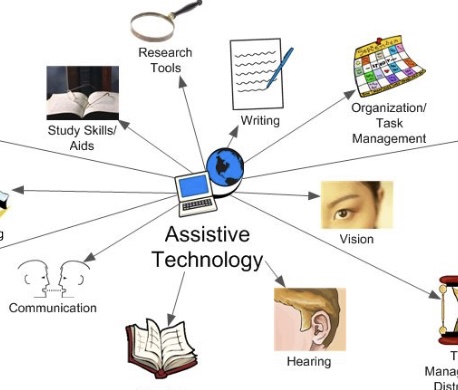WHAT IS ASSISTIVE TECHNOLOGY
Assistive technology (AT) plays a crucial role in enhancing the functional capabilities and independence of individuals with disabilities across various domains of life. It’s designed to address specific challenges that people may face due to disabilities, making tasks more manageable and improving overall quality of life.
By offering a range of options, from low-tech to high-tech solutions, AT ensures that individuals with disabilities can access the support they need, tailored to their unique requirements. This inclusivity extends to various aspects of daily living, education, communication, mobility, and more.
Additionally, the adaptability and continuous advancements in AT enable ongoing innovation, ensuring that individuals with disabilities have access to the latest tools and technologies to support their needs effectively. This dynamic field continues to evolve, driven by the goal of promoting greater accessibility, independence, and participation for people with disabilities in society.
FINANCIAL SUPPORT
In British Columbia, there are two key programs aimed at providing financial assistance to students with disabilities: the Canada Student Grant for Services and Equipment – Students with Disabilities (CSG-DSE) and the Public Postsecondary Loan (PPL).
Canada Student Grant for Services and Equipment – Students with Disabilities (CSG-DSE):
- The CSG-DSE is a grant available to eligible students with a permanent disability or a persistent/prolonged disability.
- It is accessible to students enrolled in postsecondary courses who qualify for financial assistance through Student Aid BC.
- This grant is specifically designed to assist students who require assistive technology to minimize barriers related to their disability.
- Eligible students can utilize the grant to cover the costs associated with acquiring assistive technology and receiving technical support.
Public Postsecondary Loan (PPL):
- The PPL program provides assistive technology on a loan basis to students with permanent disabilities attending public postsecondary institutions within British Columbia.
- Participants in the PPL program have access to a range of assistive equipment and software that can support their learning needs.
- Additionally, students enrolled in classes can access related services such as training and technical support to ensure they can effectively utilize the assistive technology provided through the loan program.
These programs aim to alleviate financial burdens associated with acquiring assistive technology and related support services, thereby facilitating greater access and participation in postsecondary education for students with disabilities in British Columbia.
EXCLUSION TRACKER
The BCEdAccess Exclusion Tracker is a tool designed to monitor and report on the exclusion of disabled students within the British Columbia education system. It collects data annually to highlight the barriers to equitable access to education faced by these students, with the goal of prompting systemic change. The report aims to hold educational institutions and policymakers accountable for ensuring that disabled students receive the necessary resources, support, and accommodations to fully participate in education.
Benefits of the Exclusion Tracker:
- Data Collection: It provides a systematic method of collecting data on exclusionary practices, allowing for the identification of trends and areas of concern.
- Accountability: By documenting instances of exclusion, it holds educational institutions and policymakers accountable for addressing systemic barriers and ensuring equitable access to education for disabled students.
- Advocacy: The data gathered can be used for advocacy purposes, to raise awareness, mobilize support, and push for policy changes to improve the educational experiences of disabled students.
- Informing Policy and Practice: The evidence-based data can inform the development of policies and practices aimed at promoting inclusivity and addressing the specific needs of disabled students.
Drawbacks of the Exclusion Tracker:
- Complexity of Data Collection: The process of collecting comprehensive data on exclusionary practices may be complex and time-consuming, potentially leading to challenges in obtaining accurate and complete information.
- Resource Intensive: The implementation of the Exclusion Tracker may require significant resources in terms of time, funding, and personnel to ensure effective data collection and analysis.
- Limited Scope: While the Exclusion Tracker focuses on monitoring exclusionary practices within the education system, it may have limitations in capturing all aspects of exclusion experienced by disabled individuals in other settings or contexts.
- Privacy Concerns: Collecting data on personal experiences of exclusion may raise privacy concerns for individuals sharing their stories, necessitating careful handling and safeguarding of sensitive information.
Overall, while the Exclusion Tracker serves as a valuable tool for documenting and addressing exclusionary practices in education, it’s important to acknowledge its limitations and ongoing efforts to improve data collection methodologies and ensure the protection of individuals’ privacy and rights.
